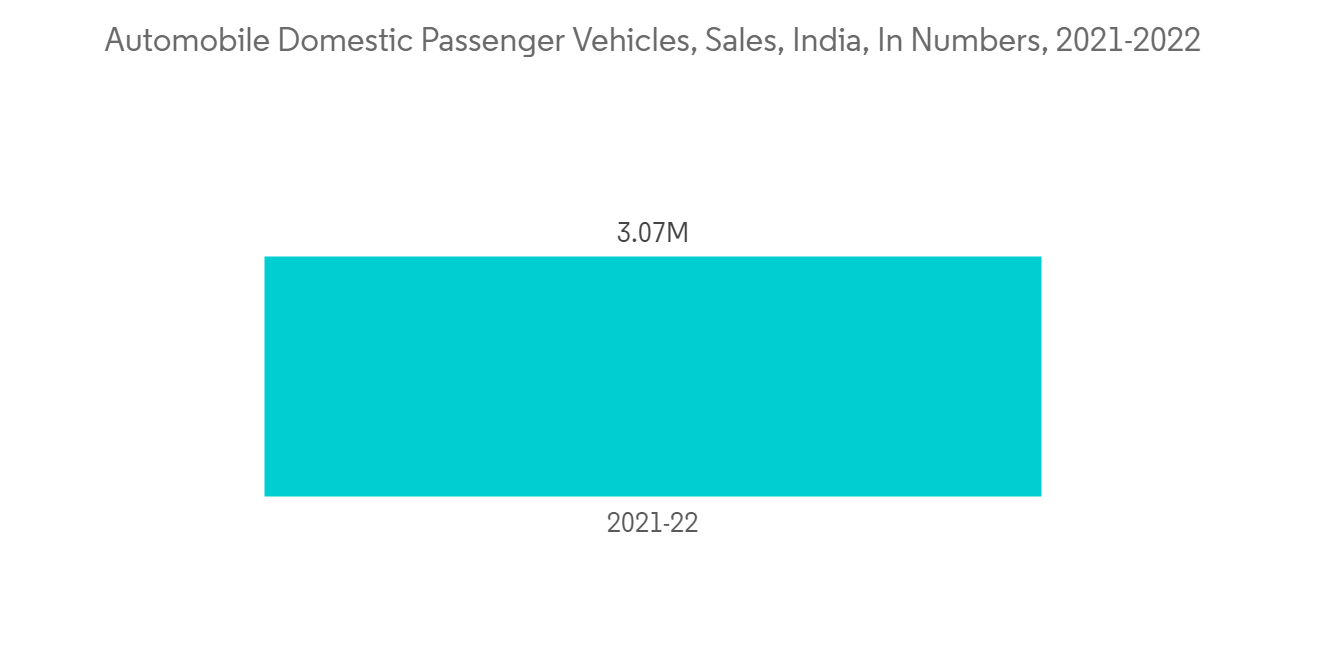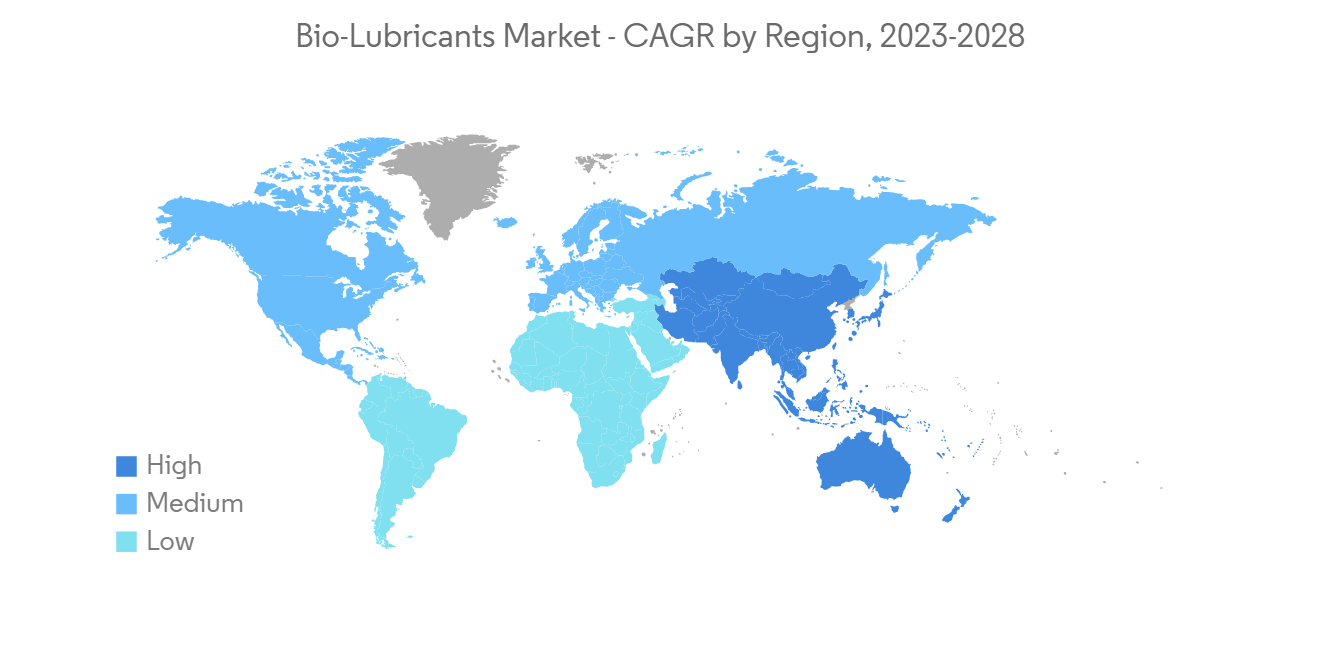Need help finding what you are looking for?
Contact Us
PUBLISHER: Mordor Intelligence | PRODUCT CODE: 1272699

PUBLISHER: Mordor Intelligence | PRODUCT CODE: 1272699
Bio-Lubricants Market - Growth, Trends, and Forecasts (2023 - 2028)
PUBLISHED:
PAGES: 120 Pages
DELIVERY TIME: 2-3 business days
SELECT AN OPTION
The bio-lubricants market is projected to register a CAGR of more than 3% during the forecast period.
Key Highlights
- COVID-19 negatively impacted the market in 2020. However, the market reached pre-pandemic levels in 2022 and is expected to grow steadily in the future.
- Bio-based lubricants do not cause skin inflammation, which is generally caused by petroleum-based lubricants. Additionally, they have various advantages, such as reduced energy usage, labor costs, increased employee safety, improved environmental conditions, increased machine life, and increased production, thereby augmenting the market's growth.
- Bio-lubricants are produced by esterifying a fatty acid or trans-esterifying vegetable oil. This process is being held with long-chain alcohol in the presence of a homogeneous acid/base catalyst 8 -10 or using an ion-exchange resin. This process increases the cost of bio-based lubricants. This is likely to hinder the market's growth.
- Various R&D projects have been completed to improve the physicochemical properties of bio-based lubricants. These studies have found that bio-lubricants can be used as substitutes for petroleum-based oils and are projected to act as an opportunity for the market.
- The Asia-Pacific region dominated the global market, with the largest consumption from countries such as China, India, and Japan.
Bio-Lubricants Market Trends
Increase in Demand for Bio-Lubricants in Automotive and Transportation Sector
- The automotive and transportation sector accounts for a considerable share of the market for bio-lubricants. The transportation industry emphasizes enhancing lubricant properties such as performance, longevity, energy efficiency, and environmental friendliness. Bio-greases work well in various applications, including construction vehicles, forestry machinery, rail flanges, rail curves, and nautical machinery.
- Many industries use bio-based metal cutting fluids and coolants for grinding, gear cutting, and general machining, which are anticipated to drive market growth. Due to their low toxicity, high viscosity index, potent lubricating properties, longer machine service life, high combustion temperature, and other characteristics, bio-based lubricants are expected to displace conventional lubricants in the automotive industry eventually.
- The expansion of the automotive sector in China is anticipated to cultivate the demand for bio-lubricants. According to the International Organization of Motor Vehicle Manufacturers (French: Organisation Internationale des Constructeurs d'Automobiles) (OICA), China is the largest producer of automobiles. The country alone produced 2,60,82,220 units of vehicles in 2021.
- Also, India witnessed a significant increase in the sales of passenger vehicles and commercial vehicles. For instance, the domestic sales of passenger vehicles were 3,069,499 for 2021-2022, representing an increase of 13% compared to 2020-21. All the aforementioned factors are expected to drive the global market during the forecast period.

Asia-Pacific to Dominate the Market
- China is the third largest bio-lubricant consumer in the Asia-Pacific region. The expanding power generation industry in the region is anticipated to drive the bio-lubricant market during the forecast period.
- In 2021, India had a capacity for more than 147.1 gigawatts of renewable energy. This was higher than the peak for the period under consideration in 2020, which was 134.5 gigawatts, supporting the market's growth significantly.
- Around 8,377 terawatt hours of electricity were produced in China in 2021. This was an increase over the previous year of almost 10%. Except for hydropower, all energy sources were more significantly consumed in 2021, with wind and solar power generating increases being majorly used.
- Moreover, the Japanese government has also been planning to build 45 new coal-fired power plants in the country by using high-energy, low-emission technology, which uses high-quality black coal. With the increasing number of power plants in the country, accelerated demand for bio-lubricants for use in power plants is expected during the forecast period.
- Therefore, this increase in the power industry is expected to drive the bio-lubricants market in the Asia-Pacific region.

Bio-Lubricants Industry Overview
The bio-lubricants market is fragmented in nature. Some of the major players in the market include BP p.l.c., Chevron Corporation., Exxon Mobil Corporation, TotalEnergies, and FUCHS, among others
Additional Benefits:
- The market estimate (ME) sheet in Excel format
- 3 months of analyst support
Product Code: 55763
TABLE OF CONTENTS
1 INTRODUCTION
- 1.1 Study Deliverables
- 1.2 Study Assumptions
- 1.3 Scope of the Study
2 RESEARCH METHODOLOGY
3 EXECUTIVE SUMMARY
4 MARKET DYNAMICS
- 4.1 Drivers
- 4.1.1 Regulatory Norms Driving the Demand for Bio-based Lubricants
- 4.1.2 Other Drivers
- 4.2 Restraints
- 4.2.1 High Price of Bio-based Lubricants
- 4.2.2 Other Restraints
- 4.3 Industry Value-Chain Analysis
- 4.4 Porter's Five Forces Analysis
- 4.4.1 Bargaining Power of Suppliers
- 4.4.2 Bargaining Power of Consumers
- 4.4.3 Threat of New Entrants
- 4.4.4 Threat of Substitute Products and Services
- 4.4.5 Degree of Competition
5 MARKET SEGMENTATION (Market Size in Value)
- 5.1 Product Type
- 5.1.1 Engine Oil
- 5.1.2 Transmission and Hydraulic Fluid
- 5.1.3 Metalworking Fluid
- 5.1.4 General Industrial Oil
- 5.1.5 Gear Oil
- 5.1.6 Grease
- 5.1.7 Process Oil
- 5.1.8 Other Product Types
- 5.2 End-user Industry
- 5.2.1 Power Generation
- 5.2.2 Automotive and Other Transportation
- 5.2.3 Heavy Equipment
- 5.2.4 Food & Beverage
- 5.2.5 Metallurgy & Metalworking
- 5.2.6 Chemical Manufacturing
- 5.2.7 Other End-user Industries
- 5.3 Geography
- 5.3.1 Asia-Pacific
- 5.3.1.1 China
- 5.3.1.2 India
- 5.3.1.3 Japan
- 5.3.1.4 South Korea
- 5.3.1.5 Rest of Asia-Pacific
- 5.3.2 North America
- 5.3.2.1 United States
- 5.3.2.2 Canada
- 5.3.2.3 Mexico
- 5.3.2.4 Rest of North America
- 5.3.3 Europe
- 5.3.3.1 Germany
- 5.3.3.2 United Kingdom
- 5.3.3.3 Italy
- 5.3.3.4 France
- 5.3.3.5 Russia
- 5.3.3.6 Rest of Europe
- 5.3.4 South America
- 5.3.4.1 Brazil
- 5.3.4.2 Argentina
- 5.3.4.3 Rest of South America
- 5.3.5 Middle East & Africa
- 5.3.5.1 Saudi Arabia
- 5.3.5.2 South Africa
- 5.3.5.3 United Arab Emirates
- 5.3.5.4 Rest of Middle East & Africa
- 5.3.1 Asia-Pacific
6 COMPETITIVE LANDSCAPE
- 6.1 Mergers & Acquisitions, Joint Ventures, Collaborations, and Agreements
- 6.2 Market Share(%)**/Ranking Analysis
- 6.3 Strategies Adopted by Leading Players
- 6.4 Company Profiles
- 6.4.1 Axel Christiernsson
- 6.4.2 Carl Bechem Lubricants India Private Limited
- 6.4.3 BP p.l.c.
- 6.4.4 Cargill
- 6.4.5 Chevron Corporation
- 6.4.6 Cortec Corporation
- 6.4.7 Environmental Lubricants Manufacturing, Inc.
- 6.4.8 Exxon Mobil Corporation
- 6.4.9 FUCHS
- 6.4.10 KCM Petro Chemicals
- 6.4.11 Novvi, LLC.
- 6.4.12 PANOLIN AG
- 6.4.13 Shell plc
- 6.4.14 TotalEnergies
7 MARKET OPPORTUNITIES AND FUTURE TRENDS
- 7.1 Introduction of New Products with Better Properties
Have a question?


SELECT AN OPTION
Have a question?


Questions? Please give us a call or visit the contact form.
